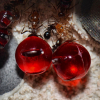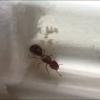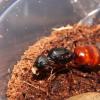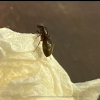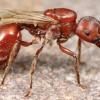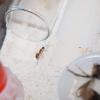I thought I'd make my first post a good one, so what better way to do this than with a multispecies honeypot ant colony? As the title suggests, I believe I am the first person to successfully found a multispecies honeypot ant colony in the world, and possibly the first successful multispecies colony in North America. A Myrmecocystus mexicanus and mimicus queen were placed together within a couple days of being caught from their nuptial flight roughly a month and a half ago and have founded together with the first mimicus worker hatching on September 4th, and the first mexicanus worker hatching today on September 5th, making it a true multispecies colony at this point. As you can see both the queens and workers are healthy with no signs of hostility to each other so far. Hopefully more workers continue hatching in the days to come. Whether or not this will work long term only time will tell, but regardless, I would say the fact that this worked is an amazing discovery in it of itself.

Edited by UrbanOrganisms, September 5 2021 - 9:26 AM.


